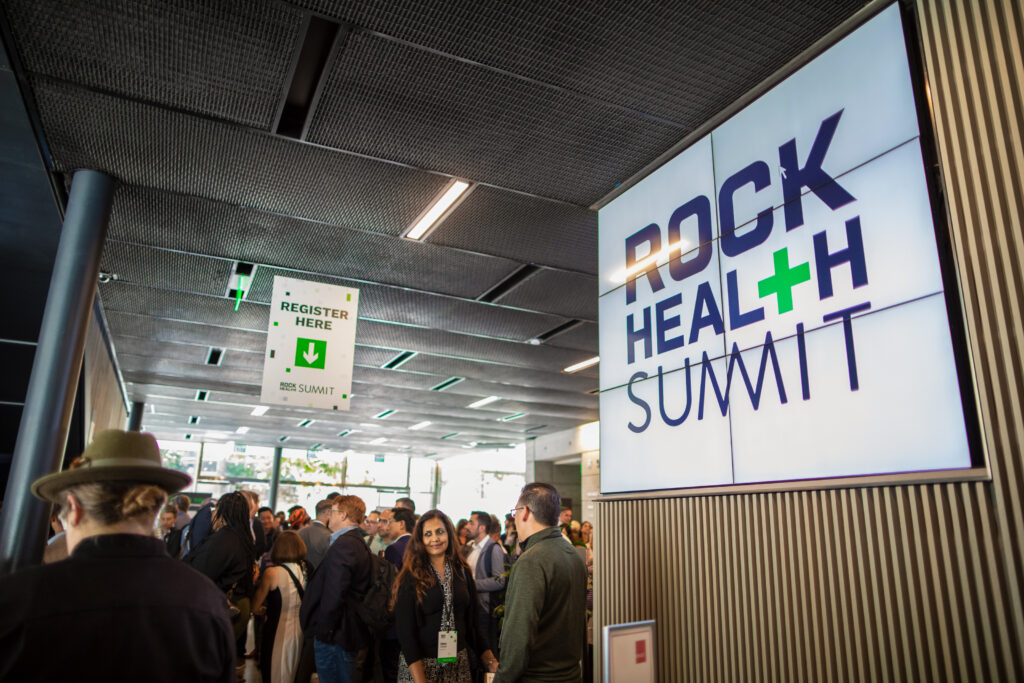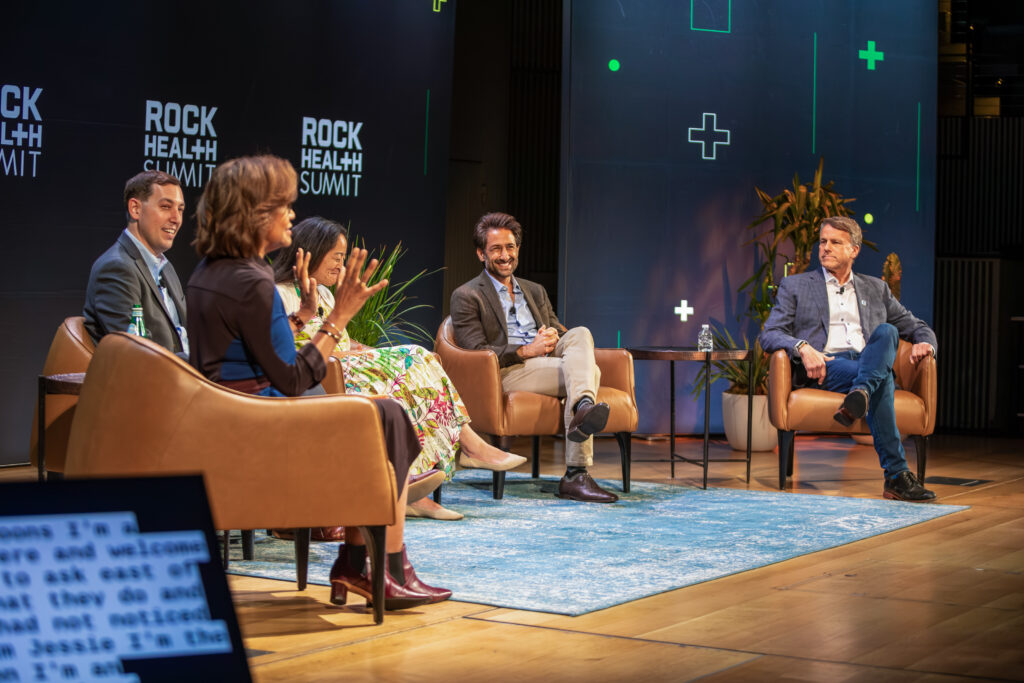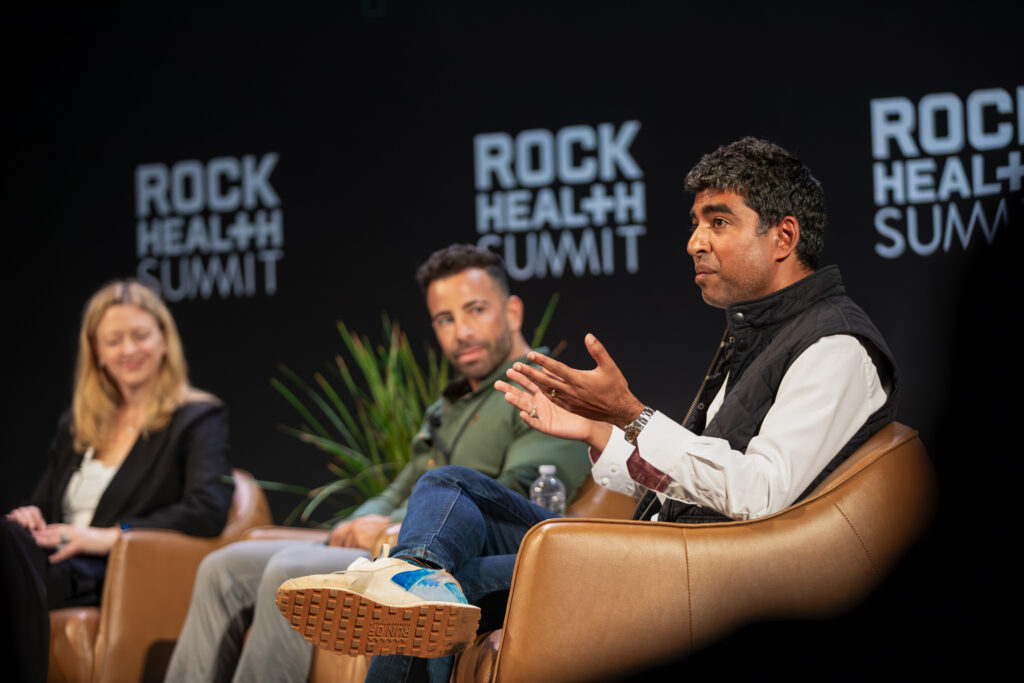Designing for the new frontier: Reflections from Rock Health Summit 2023
Last week, Rock Health gathered digital health innovators in San Francisco, and over a global livestream, for Rock Health Summit 2023—a day of inspired conversation and connection with some of the brightest minds in technology, medicine, health care, and public health.
Festivities started the evening of Tuesday, September 26, with the Top 50 in Digital Health Awards dinner where we recognized 50 digital health innovators working to make healthcare massively better for all. The honorees were celebrated for the work they do in healthcare as Disruptors, Public Health Leaders, Frontline Heroes, Equity Advocates, Luminaries, and so much more. Congratulations to this year’s honorees and thank you for your commitment and dedication to this work!
Rock Health Summit kicked off the following day on September 27. Fifty-one percent of attendees identified as women and the full spectrum of the industry was represented, including leaders from startups (26%), venture (20%), and biotech (11%). We were also thrilled to be joined by the 2023 RockHealth.org Innovation Fellows—a dynamic group of 10 leaders who are pioneering advancements in mental health, end-of-life care, pediatric telehealth, trauma care, and more. The Innovation Fellows represent a diverse range of perspectives, expertise, and lived experiences.
The day was packed with conversation, both on the stage and in the hallways. We’ve distilled down the most memorable takeaways as the curtains close on this year’s Summit. We hope they provide inspiration as you continue to innovate and reimagine the future of healthcare.

Go slow, build evidence
In the race to scale and meet the accelerated demands prompted by the COVID-19 pandemic, creating digital health products supported by evidence-based guidelines may have gotten lost in the shuffle. As the industry has shifted to a tighter economic climate more recently, payers are calling for solutions with a proven ability to improve health outcomes. In today’s environment where consumers have so many more options than ever before, earning trust is paramount to creating winning products. Panelists with varied experiences–from direct service care, to social entrepreneurship, to venture capital–remarked that sustaining an equitable and innovative company requires a dogged orientation to build toward consumers and outcomes. However, as Carolyn Witte from Tia noted, digital health’s previous focus in 2021 – 2022 on revenue growth at all costs was at the disservice of truly making individuals healthier.
To meet the needs of payers, experts commented on the importance of building intentionally and slowly. Two examples of leaders already thinking about this approach are Kiyana Turner and Javier Garcia Palacios. Kiyana from Children’s Hospital Los Angeles noted that as a pediatric institution, their work moves especially cautiously in embracing new innovation, and specifically works to identify outcomes of interest through peer-reviewed studies. Others throughout the day shared a similar mindset to prioritize moving slowly, whether through iteratively modified programming to address the nuances of a geographic location, hub and spoke models, or depending on rigorous evidence to gain trust and credibility. Javier from Roche summed it up best stating, “Evidence takes time. In the first and second act that is what was missing, the rigor of the evidence.” While speed and agility are critical, they cannot be prioritized at the expense of generating quality clinical and economic evidence.

Experience design comes to the home
Elderly adults are increasingly asking for the dignity of aging at home. We are fast approaching a population, where by 2034, one in three households will be led by someone who is 65+. Anika Heavener of The SCAN Foundation, in a Summit Virtual Series session, remarked on an increase in willingness and opportunities by funders and entrepreneurs to support work around aging. She described seeing this take the form of reinforcing current healthcare structures for the aging population or working to build a market that centers aging populations in their decision-making journeys.
Cameron Carter of Rock Health Capital portfolio company Rosarium, commented that addressing the needs of the aging population first calls on recognizing the home as a built environment, which underlies its function as a social determinant of health (SDOH). In the context of a healthcare system that was never designed to address the needs of people of color and marginalized individuals, designating the home as a primary provider of care is an opportunity for inclusive, person-centered care. Krista Drobac of Moving Health Home commented on how shifting care to the home flips the power dynamic for individuals who, in many cases, were justifiably suspicious of the healthcare setting. Examples from across the industry have shown that there is a greater amount of patient trust when the provider is the invited guest in the home. It’s a mutual benefit for providers, as delivering care in the home provides the unique opportunity to address a broader range of SDOH factors, with the overall outcome boosting equitable care.
In thinking through logistics, elevating the home to a facility capable of providing care underscores a need to address accessibility and home modifications quickly and efficiently. This extension of care also requires an expansion of the labor market to provide reliable and supported in-home care. This brings in the need to address multi-user care for the caregiver, provider, and patient in designing thoughtfully connected care networks. As Ricky Choi from Samsung, noted, “The needs of the caregiver and needs of the care recipient are quite different—and how they would like to experience healthcare is different.” Following this thread, multi-user experience design in the home has the capability to contribute to fostering a healthcare future where inclusive and supportive care is the norm.

Balancing frontlines and frontiers
Looking back, leaders on the mainstage remarked that previous digital health innovator decisions were made in a lower interest rate environment—where venture growth capital was easily found and readily accessible. As Emily Melton from Threshold stated however, there will be few opportunities for venture capital-backed businesses to grow exponentially in the coming decade given the economic environment. Aspiring and existing entrepreneurs need to orient around and through these changing market conditions. Meera Mani of Town Hall Ventures remarked that there is a new emphasis on consumer affordability that requires a different approach towards customers that both fosters engagement while also enhancing experiences.
Facing these challenges, leaders on the stage agreed on the need to throw out previous financial expectations. Healthy companies are learning that you have to work from within the system and its complex structures and incentives to drive scaled and sustainable change. Fueling solutions in this context requires collaborative partnership and willingness to understand the financial incentives and alignment that drive adoption.

We were thrilled to be in community with some of the brightest minds in digital health at Rock Health Summit. We look forward to how the ideas and reflections shared continue to spark healthcare innovation. We’re already counting down to next year—save the date for Tuesday, September 10, 2024 for the 13th annual Rock Health Summit! For more information about attending or sponsoring Rock Health Summit 2024, reach out to us. To keep in touch with RockHealth.org and stay updated on events, sign up for our mailing list here.
We want to extend a special thank you to all of our speakers and attendees for sharing their experience and time! And to our wonderful sponsors—The Top 50 in Digital Health Awards and Rock Health Summit would not be possible without this group of committed partners: Fenwick, American Medical Association, Google Health, The SCAN Foundation, Tulsa Innovation Labs, California Health Care Foundation, Hopelab, Verizon, and Leerink Partners.

